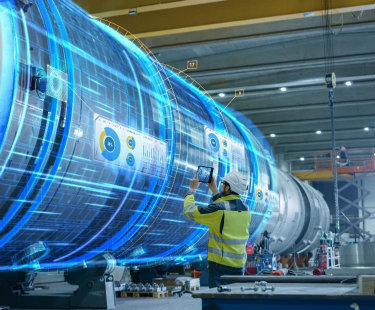The Westinghouse Solution
Nuclear power plant uprating is a timely and cost-effective way to provide incremental electric generation. Westinghouse has successfully implemented more than 150 plant upratings, providing more than 5000 MWe of additional power generation worldwide.
Today, Westinghouse has become the undisputed world leader in power uprating with the added resources of Stone & Webster engineering, whose experience includes 40 years performing more than 77 power uprates on the Balance of Plant (BOP) for both Pressurized Water Reactor (PWR) and Boiling Water Reactor (BWR) technologies. This includes the engineering, procurement, work planning and installation of modifications. This added capability provides the integrated competence to address both the Nuclear Steam Supply System (NSSS) and BOP for PWR technologies, as well as the BOP for BWR technologies.
Similarly, with the addition of the legacy BHI Energy business, a nationally recognized maintenance and modification contractor (MMC), Westinghouse can perform the entire scope of delivery for the power uprate program including the expert panel, feasibility study, licensing, detailed engineering, procurement, and installation services.
Westinghouse currently provides all three types of uprating programs recognized by the U.S. Nuclear Regulatory Commission (NRC):
- Measurement uncertainty recapture (MUR) power uprate: X < 2%
- Taking advantage of improved power measurements to lower the power calorimetric uncertainty.
- Stretch power uprate (SPU): 2% < X < 7%
- Raising power to within the design capacity of the plant.
- Extended power uprate (EPU): X > 7%
- Increased power may require significant modifications to major NSSS components (e.g., replacement steam generators) or BOP equipment (e.g., high-pressure turbines, condensate pumps and motors, main generators and/or transformers).
Customer Benefits
A thermal power increase in the nuclear steam supply system and upgrades to the balance of plant garners additional revenue from increased power generation and improved thermal performance. It also updates the design and licensing basis of a plant by utilizing enhanced analytical methods and improved materials and equipment, which allows for overall system design improvements based on operating experience. An uprate can additionally provide cost savings and synergies with other Long-Term Operation (LTO) asset management programs including equipment efficiency upgrades, license renewal and life extension, and improved fuel cycle management. An uprating provides a cost-effective opportunity to assess and use design and analysis margin.
Uprate Program Description
Westinghouse’s recommended three-phase process for power uprates has resulted in a 100 percent success rate for achieving upratings at plants worldwide.
Each power uprate phase is structured to develop specific information and optimize customer participation that will support decision-making and establish the basis for the uprate project. In addition to our proven processes and lessons learned, we utilize the applicable guidance of NEI-08-10 and EPRI Technical Report, “Facilitating Power Uprates at Nuclear Power Plants: Feasibility Study Guideline” July 2023. However, there is considerable flexibility in the way an uprating can be approached. The program scope can be modified to accommodate client requirements and plant needs.
Phase 1 – Joint Expert Panel
Integrated with the client and key vendors, the panel jointly:
- Utilizes plant data and analysis to determine the recommended target power level.
- Identifies limiting plant features and regulatory approval issues.
- Provides preliminary schedule and rough order of magnitude with uncertainty estimates for implementation of the power uprate.
Phase 2 – Feasibility Study
Using the Expert Panel results, the detailed feasibility study confirms the optimum power level by performing detailed engineering calculations and analysis, which:
- Establishes the optimum uprate level considering cost, schedule, and other plant impacts.
- Demonstrates the feasibility of uprating the NSSS power as it affects components/systems.
- Confirms uprate feasibility by performing calculations using proven methods and approaches based on previous core uprate experience for selected accidents.
- Based on the power level, perform heat balance calculations to evaluate margins and pinch points of components/systems, identifying those components that require modification or replacement under normal, transient, and accident conditions at the proposed uprate power level and recommends margin usage and tradeoffs, in fuel design, operating parameters and regulatory approach.
- Identifies further analyses that are required in the follow-on phase of the uprate project to justify the proposed uprate and provides budgetary estimates for implementation.
- Defines plant modifications necessary to accomplish the uprating, together with establishing order-of-magnitude cost estimates and supporting schedule for engineering, procurement, and plant modifications.
- Evaluates the potential impact the uprating may have on existing surveillance or scheduled maintenance requirements.
- Evaluates the potential impact the uprating may have on the service life of selected key components.
- Evaluates the environmental impacts, including thermal discharge to the ultimate heat sink at the new power level.
- Develops bounding cost estimates and schedules to implement the targeted power uprate.
The results of the feasibility study are detailed in a report that includes a discussion of evaluations performed, results and conclusions, and provides the recommended optimum uprate power level, plant modifications, project execution plan, and the associated budget estimate and schedule.
Phase 3 – Implementation Phase
With the completion of the feasibility study, the detailed engineering, licensing, procurement, and installation activities can begin in earnest. During this phase, the following key activities are performed:
- Detailed engineering, including evaluations and calculations to demonstrate that the design basis of components and systems are acceptable at the targeted uprated power level. Development and finalization of the detailed execution plan including organization, cost and schedule, logistics and cash flow analysis for the completion of the detailed engineering, licensing, procurement of materials and equipment, delivery/storage, supervision, craft and subcontractor mobilization and installation of the modifications to the plant.
- Preparation of engineering change packages that will define the plant modifications.
- Development of procurement specifications for long lead material and equipment including the evaluation of the impact the uprate has on operating margins.
- Development of input to support the integrated licensing report for submittal to the U.S. NRC. The licensing report sections are developed for the client and incorporate the guidance provided in NRC Document RS-001, Revision 0 for review of uprate applications, which enhances consistency, quality, and completeness of the reviews.
- Preparation of setpoint and scaling calculations, to support engineering change packages, and if needed, performing piping vibration monitoring evaluations.
- Preparation of installation Work Packages to perform the installation modifications.
- Development of field engineering plans to support the installation of required modifications.
- Development of power ascension plans and test requirements; identifying procedure and program changes, training of client personnel and other tasks as identified by the client.
- Simulator upgrades as required to incorporate the plant uprating into those models.
As part of a total integrated approach, Westinghouse has the experience and capability to support each of the critical work steps to ensure that the optimum power levels are achieved, providing the client the maximum flexibility for engagement in each phase of the project, while ensuring the objectives of the program are achieved.

